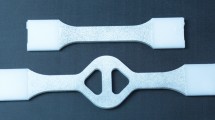Abstract
A new device for conducting tensile and compressive tests at strain rates ranging from about 20 s−1 to 250 s−1 is presented. The operation of the device is based on the principles of the Split Hopkinson Bar (SHB) technique, except that the incident bar is replaced by a fast hydraulic actuator and the transmitter bar is very long. One end of the specimen, which is short and has a small cross-sectional area relative to the cross-sectional area of the transmitter bar (like in a SHB test) is attached at one end of the transmitter bar. During a test the actuator applies a force to the specimen. Upon loading the specimen deforms between the actuator and the end of the transmitter bar and a tensile, or compressive, wave starts propagating along the bar. The wave travels to the end of the transmitter bar and reflects back. The force in the specimen is determined from the amplitude of the wave. Digital Image Correlation (DIC) is used to measure the deformation directly on the surface of the specimen. The 40 m long transmitter bar provides 15 ms of time to conduct a test. Stress strain curves from tensile and compression tests with the new device are clean and smooth without any evidence of oscillations or ringing.











Similar content being viewed by others
References
Diot S, Guines D, Gavrus A, Ragneau E (2007) Two-step procedure for identification of metal behavior from dynamic compression tests. Int J Impact Engineering 34:1163–1184
Kopp R, Luce R, Leiesten B, Wolske M, Tschirnich M, Rehrmann T, Volles R (2001) Flow stress measuring by use of cylindrical compression test and special application to metal forming processes. Steel Res 72:394–401
Boyce DL, Dilmore MF (2009) The dynamic tensile behavior of tough, ultrahigh-strength steels at strain-rates from 0.0002 s−1 to 200 s−1. Int J Impact Engineering 36:263–271
Huh H, Lim JH, Park SH (2009) High speed tensile test of steel sheets for the stress-strain curve at the intermediate strain rate. Int J Automot Technol 10:195–204
Othman R, Guegan P, Challita F, Fasco F, LeBreton D (2009) A modified servo-hydraulic machine for testing at intermediate strain rates. Int J Impact Engineering 36:460–467
Zhu D, Rajan SD, Mobasher B, Peled A, Mignolet M (2011) Model analysis of a servo-hydraulic high speed machine and its application to dynamic tensile testing at an intermediate strain rate. Exp Mech 51:1347–1363
Zhu D, Mobasher B, Rajan SD, Peralta P (2011) Characterization of dynamic tensile testing using aluminum alloy 6061-T6 at intermediate strain rates. J Eng Mech 137:669–679
Kolsky H (1949) An investigation of the mechanical properties of materials at very high rates of loading. Proc Phys Soc B 62(11):676–700
Gray GT III (2000) Classic split-Hopkinson pressure bar testing. In: Kuhn H, Medlin D (eds) ASM handbook, vol 8. ASM International, Materials Park, pp 462–476
Harding J, Welsh LM (1983) A tensile testing technique for fibre-reinforced composites at impact rates of strain. J Mater Sci 18:1810–1826
Staab GH, Gilat A (1991) A direct-tension split Hopkinson bar for high strain-rate testing. Exp Mech 31:232–235
Song b SCJ, Grupido CL, Chen W, Lu WY (2008) A long split Hopkinson pressure bar (LSHPB) for intermediate-rate characterization of soft materials. Exp Mech 48:809–815
Zhao H, Gary G (1997) A new method for the separation of waves. Application to the SHPB technique for an unlimited duration of measurement. J Mech Phys Solids 45:1185–1202
Othman R, Gary G (2007) Testing aluminum alloy from quasi-static to dynamic strain-rates with modified split Hopkinson bar method. Exp Mech 47:295–299
Whittington WR, Oppedal AL, Francis DK, Horstemeyer MF (2015) A novel intermediate strain rate testing device: the serpentine transmitted bar. Int J Impact Engineering 81:1–7
Acknowledgements
The research reported in this paper was supported by NASA (NRA Grant NNX08AB50A). Many thanks are due to the project manager, Dr. Mike Pereira of NASA Glen Research Center. Upgrading of the hydraulic actuator was supported by Honda R&D Americas, Inc. The help and advice of Mr. Duane Detwiler is greatly appreciated.
Author information
Authors and Affiliations
Corresponding author
Additional information
Publisher’s Note
Springer Nature remains neutral with regard to jurisdictional claims in published maps and institutional affiliations.
A. Gilat and J.D. Seidt are members of the Society for Experimental Mechanics.
Rights and permissions
About this article
Cite this article
Gilat, A., Seidt, J., Matrka, T. et al. A New Device for Tensile and Compressive Testing at Intermediate Strain Rates. Exp Mech 59, 725–731 (2019). https://doi.org/10.1007/s11340-019-00488-1
Received:
Accepted:
Published:
Issue Date:
DOI: https://doi.org/10.1007/s11340-019-00488-1




